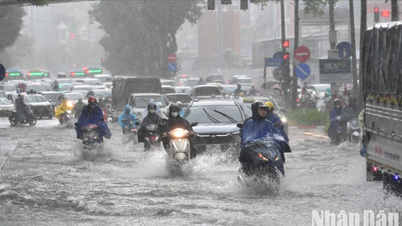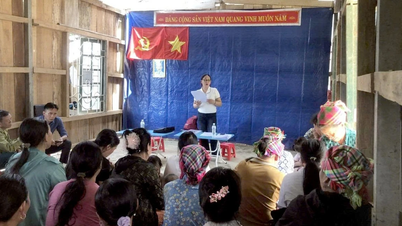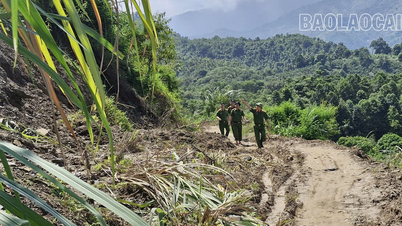
Besides, a strong digital infrastructure is also a prerequisite for our country to master and effectively exploit strategic technologies such as AI, IoT, Big Data, Cloud, Blockchain, semiconductors, 5G and 6G.
Digital infrastructure includes four main components: telecommunications and internet infrastructure; data infrastructure; physical-digital infrastructure; digital utility infrastructure and digital technology . Vietnam's viewpoint is that digital infrastructure will be planned and deployed in parallel and synchronously with traffic infrastructure, electricity infrastructure, lighting infrastructure, underground construction infrastructure and other technical infrastructures.
Recorded many developments
The digital economy is currently playing an important role in the global economy. In Vietnam, it is expected that by the end of 2025, the digital economy will contribute about 20% of GDP and Resolution No. 57-NQ/TW of the Politburo sets a target of this ratio reaching 30% by 2030. Among the 5 main components ensuring the development of the digital economy mentioned by the World Bank (WB), digital infrastructure is always the top priority.
Professor Ho Tu Bao, Institute for Advanced Study in Mathematics, member of the National Advisory Council on Science and Technology, Innovation and Digital Transformation, commented: A strong digital infrastructure first of all requires a system of machines and equipment at all levels, from end users to servers, data storage, high-performance computers; at the same time, it must ensure widespread network connectivity at high speed. Along with that, data must be "correct, sufficient, clean, alive" and built according to a unified architecture, shared, without "separatism" in data. In particular, application infrastructure needs to have a full range of platforms and tools to deploy all socio-economic activities.
According to the Telecommunications Department (Ministry of Science and Technology), domestic telecommunications enterprises have deployed about 318,000 base transceiver stations covering 3G, 4G, 5G mobile broadband to more than 99.8% of the population. Regarding the 5G network alone, it is expected that by the end of 2025, Vietnam will set a target of reaching nearly 69,000 5G stations, equivalent to more than 57% of 4G stations, covering 90% of the population and moving towards 99% of the population by 2030.
Vietnam currently has about 105 million mobile broadband internet subscribers and about 25 million fixed internet subscribers. Fiber optic cable systems have been extended to all communes and wards across the country with a total network length of more than 1.2 million kilometers. The IPv6 deployment rate has exceeded 60%, placing Vietnam in second place in the ASEAN region and ninth place globally.
Vietnam's data infrastructure has also seen many breakthroughs in recent years. According to the VNCDC 2024 Report, the cloud computing market in Vietnam reached nearly VND 19,375 billion (equivalent to 775 million USD) in 2024, expected to increase to 1.24 billion USD in 2025 and double in 2029. Data center capacity is growing strongly, from 45 MW in 2024, it is forecast to increase to 525 MW in 2025 and nearly 1,000 MW in 2030.
However, Professor Ho Tu Bao also pointed out many limitations in the development of digital infrastructure in our country. That is, there is a lack of high-performance computers to exploit big data sources and enter strategic technology. On the other hand, our data basically does not follow a unified overall architecture, thus hindering interconnectivity and sharing; digital utilities and digital technology, although widely deployed to serve many fields, especially in providing online public services, have not applied many core technologies and have not exploited big data sources.
Transparent legal framework
The viewpoint of the Digital Infrastructure Strategy to 2025 and orientation to 2030 is that the State will create a favorable development environment for enterprises of all economic sectors to participate in investing and developing digital infrastructure. This strategy will help telecommunications and digital technology enterprises identify new development spaces and build their own development orientations in the period 2024-2030.

Implementing Decision No. 620/QD-TTg approving the Project on restructuring Vietnam Posts and Telecommunications Group (VNPT) for the period up to 2025, VNPT has been taking important steps in restructuring to become a technology corporation with digital infrastructure, digital technology and digital services as the mainstay, owning and exploiting the platforms and infrastructure pillars of the national digital infrastructure.
Deputy Head of VNPT Technology Nguyen Quoc Khanh said: VNPT will strive to pioneer in building, developing and mastering national digital infrastructure based on core technologies 5G, Cloud, IoT, AI, Data, Blockchain, etc. in a powerful way, ensuring sovereignty, security and safety.
The Group has set out the principle of developing open, flexible and reliable digital infrastructure with multi-layer platform technologies. Specifically, building infrastructure with "digital highways" with many priority lanes (flexible), many standardized entrances (open) but controlled (reliable). Notably, digital infrastructure will be automated and energy-saving to reduce costs, while sharing revenue for the ecosystem to develop together.
To develop a strong digital infrastructure, according to Professor Ho Tu Bao, the State needs to continue to improve policies and ensure that sectoral, regional, and provincial planning are ready for digital infrastructure development. The legal framework and laws related to the exploitation and construction of digital infrastructure need to be transparent, non-overlapping, and avoid creating institutional “bottlenecks.”
In addition, the State needs to build an overall architecture for national digital transformation, emphasizing a unified national data architecture to be able to share and exploit at different levels. Digital infrastructure must also ensure the ability to withstand and adapt to natural disaster risks and cyber attacks. Regarding human resources, we need to build and gather a team of highly qualified experts to research, develop and master strategic technologies.
Chief of Office of the National Data Association Nguyen Thi Ngoc Dung shared: The Data Law and the Law on Personal Data Protection (2025) recently passed by the National Assembly are strategic steps, demonstrating the vision of turning data into national strength.
In the coming time, the National Data Association will focus on standardizing the national data architecture through the announcement of the Strategic Data Framework and the Data Assessment Criteria; at the same time, promoting the development of Vietnamese-owned platform technologies through investment programs from the fund to form the data industry. In particular, the Association will soon launch the Global Data Experts Network with nearly 100 scientists, ready to coordinate to solve the country's problems and support Vietnam in perfecting the legal framework on data.
Source: https://nhandan.vn/phat-trien-ha-tang-so-hien-dai-an-ninh-an-toan-va-ben-vung-post912996.html






![[Photo] Prime Minister Pham Minh Chinh chairs the Government's online conference with localities](https://vphoto.vietnam.vn/thumb/1200x675/vietnam/resource/IMAGE/2025/10/5/264793cfb4404c63a701d235ff43e1bd)
![[Photo] Prime Minister Pham Minh Chinh launched a peak emulation campaign to achieve achievements in celebration of the 14th National Party Congress](https://vphoto.vietnam.vn/thumb/1200x675/vietnam/resource/IMAGE/2025/10/5/8869ec5cdbc740f58fbf2ae73f065076)












![[Photo] Prime Minister Pham Minh Chinh chairs the Government's online conference with localities](https://vphoto.vietnam.vn/thumb/402x226/vietnam/resource/IMAGE/2025/10/5/264793cfb4404c63a701d235ff43e1bd)































![[VIDEO] Summary of Petrovietnam's 50th Anniversary Ceremony](https://vphoto.vietnam.vn/thumb/402x226/vietnam/resource/IMAGE/2025/10/4/abe133bdb8114793a16d4fe3e5bd0f12)

![[VIDEO] GENERAL SECRETARY TO LAM AWARDS PETROVIETNAM 8 GOLDEN WORDS: "PIONEER - EXCELLENT - SUSTAINABLE - GLOBAL"](https://vphoto.vietnam.vn/thumb/402x226/vietnam/resource/IMAGE/2025/7/23/c2fdb48863e846cfa9fb8e6ea9cf44e7)



































Comment (0)